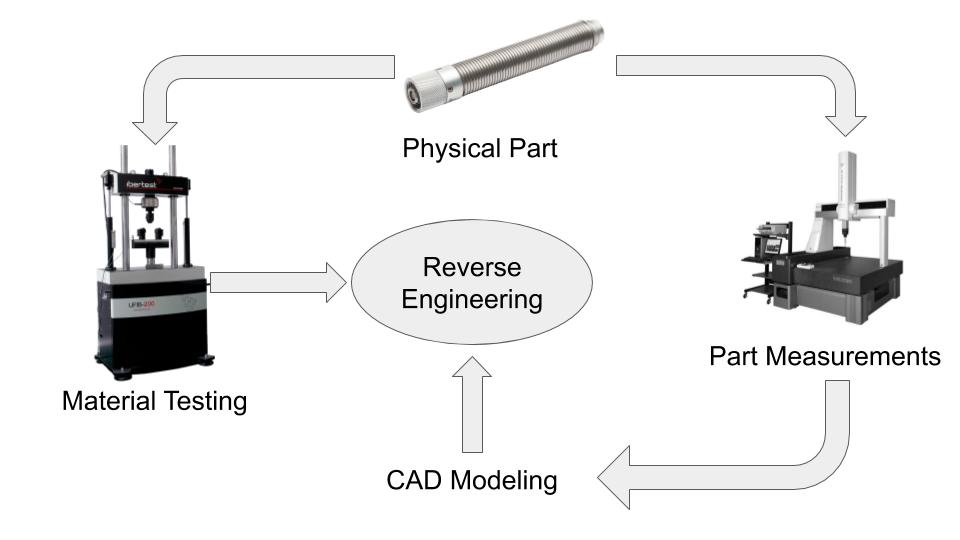Reverse engineering in product design has applications to re-engineer old products & services to design new products. This article covers what is reverse engineering, its advantages, and its process in new product design.
What is Reverse Engineering?
Reverse engineering/re-engineering or back-engineering is a process to analyze the existing product, process, or component to understand its working, function, design intent, and architecture.
Here products can be software code, mobile apps, IoT, electronics, or mechanical products. Engineers may or may not have the final product even before the start of the reverse engineering project.
Engineers work does reverse engineering in product design to understand the existing product design and finalize new product design specifications.
Applications of Reverse Engineering in Mechanical Product Design
Here is the list of reverse engineering applications in the mechanical product design and engineering.
1. Knowledge Buildup
Re-Engineering helps in building engineering knowledge. Engineers learn from the products around them.
For example, when you are working on an IP67-rated enclosure first time. The best approach is to understand legacy and competitor IP67-rated product design. It will increase your knowledge of IP 67 products. Therefore you can design better products.
But at the same time, Re-engineering should not be considered a tool to copy designs.
2. Bench-Marking and Competitor Analysis
Re-engineering is the best way to benchmark your products and make them better than the competition.
3. Recreate Obsolete Parts
Hobbyists use the Re-engineering approach to replace obsolete parts. For example, if old machine spare parts are obsolete, you can re-design parts and 3D print them.
4. Failure Analysis
Reverse engineering is used to find the root cause of a failure. In this way, you can solve engineering problems faster and effectively.
5. Legacy Components
Sometimes data for legacy components are not available or available as 2D drawings. Engineers use a reverse engineering approach to re-generate legacy products’ 3D cad data and engineering drawings.
6. Value Engineering: Improving Existing Products
Companies need to improve their products to become a market leaders. Back engineering is an effective tool for value engineering.
Reverse Engineer Process for Product Design
Reverse engineering of a product requires a broader knowledge of all engineering fields such as mechanical, electrical, and software. Let’s try to understand the reverse engineering process in product design with an example.
Reverse Engineering for an IoT Product
Following is the list of steps to reverse engineer an IoT Product such as GPS Tracker.
Step-1: Know the specification of the Product
Understanding a product specification is the first step in understanding a product’s key features for benchmarking.
Step-2: Product Tear-down
Various popular product tear-downs websites (such as IFIXIT) are available online. Product tear-down helps engineers to understand the product assembly disassembly process, internal mechanisms, etc.
Step-3: Understanding Key Features
Each product has some selling features such as led indication (i personally like Ring doorbell indication), switch design, materials, GPS antenna positioning, etc.
You can build your product knowledge by understanding its key selling features.
Step-4: Understanding PCB or Hardware
PCB is the brain of the IoT product. Identifying various PCB components (such as processor, GPS module, other sensors, etc.) is very helpful in understanding PCB key features.
How to Reverse Engineer a Mechanical Component
Reverse engineering of a mechanical part involves the following two activities.
- Part dimension measurements.
- Getting material details.

1. Part Dimension Measurements
Conventionally a part dimension was measured using measurement tools such as Vernier scale, dial gauge, VMM, CMM, etc. But measurement tools have limitations in the measurement of complex 3D surfaces.
You can use 3D Scanners to measure complex 3D surfaces. 3D scanners are not very accurate but solve the purpose.
These 3D scanners give .stl data as output. You can make a part or component CAD model if part dimensional information or .stl data is available.
2. Material Details
A lot of expertise is required to determine mechanical part material and finish details. Mechanical and chemical testing is used to determine material properties.
We will keep updating more information on what is Reverse Engineering? and how to reverse engineer a product? Add your suggestions, comments, or questions in the comment box.

Add a Comment